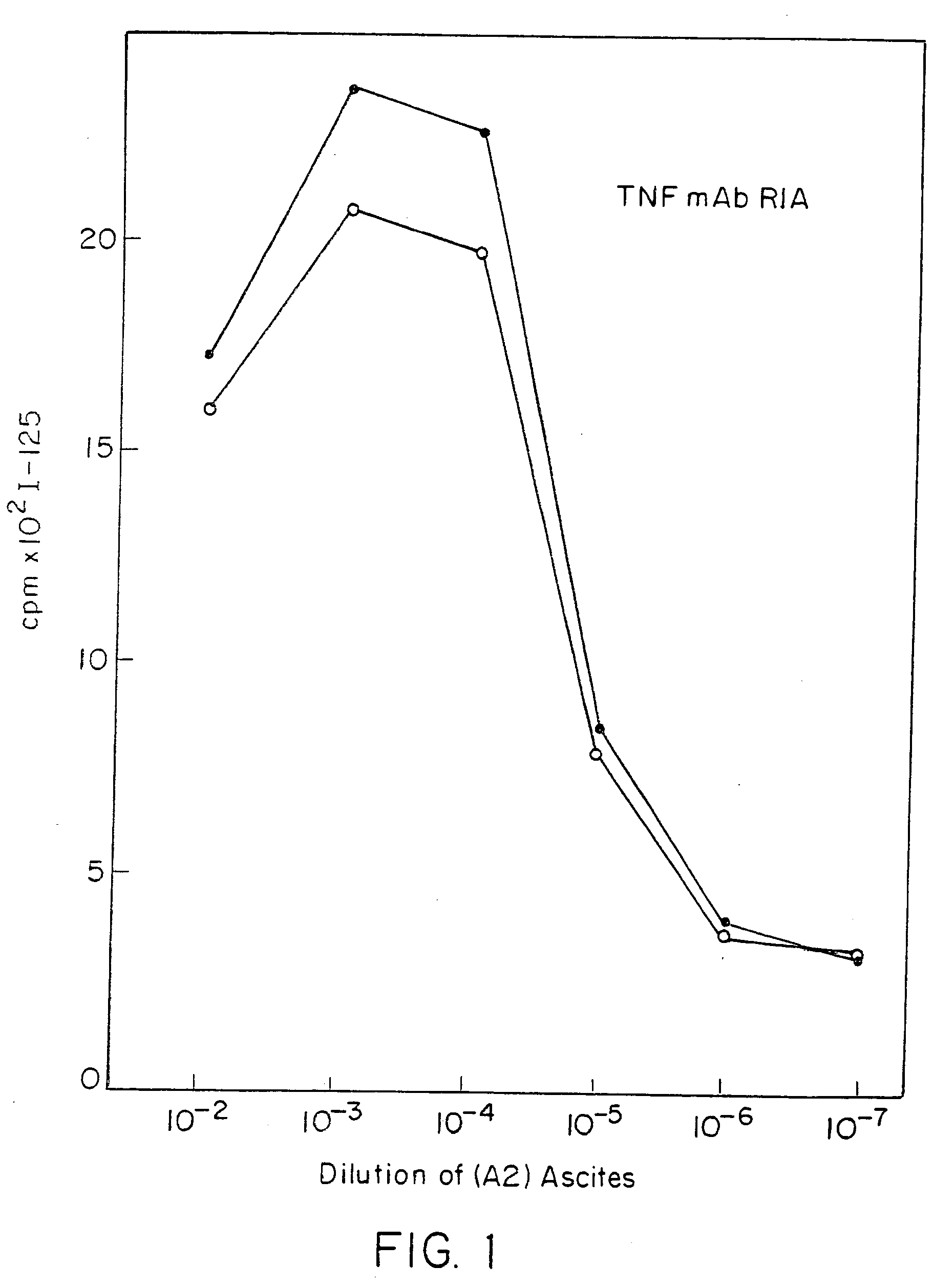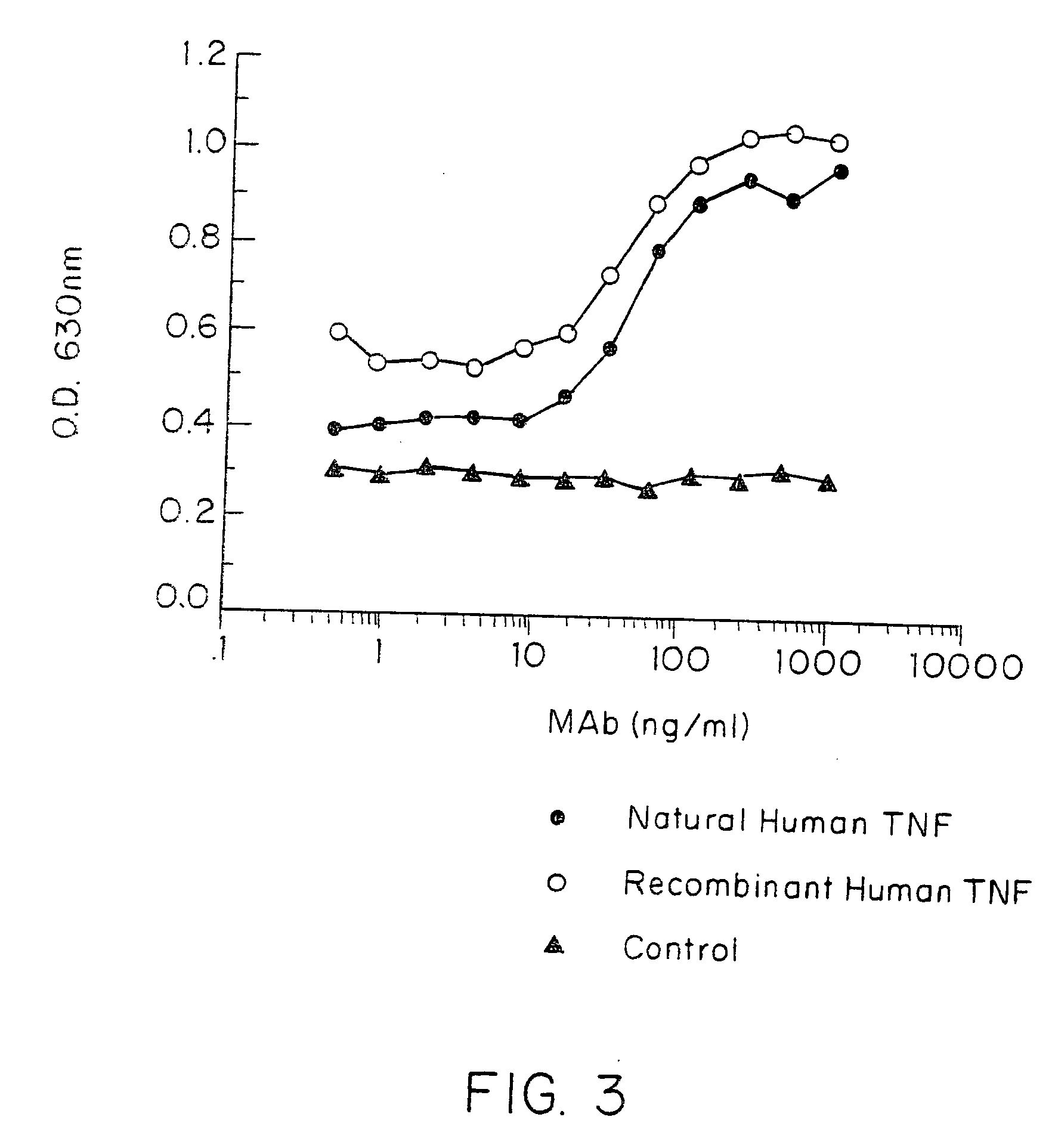Anti-TNF antibodies and peptides of human tumor necrosis factor
a human tumor necrosis factor and antibody technology, applied in the field of immunology and medicine, can solve the problems of limited human experience with anti-tnf murine mab therapy, decreased effectiveness of continued administration, and inability to provide a basis for producing tnf neutralizing antibodies that can be used in in vivo diagnostic or therapeutic purposes
- Summary
- Abstract
- Description
- Claims
- Application Information
AI Technical Summary
Problems solved by technology
Method used
Image
Examples
example i
Production a Mouse Anti-Human TNF mAb
[0347] To facilitate clinical study of TNF mAb, a high-affinity potent inhibiting and / or neutralizing mouse anti-human TNF IgG1 mAb designated A2 was produced.
[0348] Female BALB / c mice, 10 weeks old, were obtained from the Jackson Laboratory (Bar Harbor, Me.). Forty μg of purified E. coli-derived recombinant human TNF (rhTNF) emulsified with an equal volume of complete Freund's adjuvant (obtained from Difco Laboratories) in 0.4 ml was injected subcutaneously and intraperitoneally (i.p.) into a mouse. One week later, an injection of 5 μg of rhTNF in incomplete Freund's adjuvant was given i.p. followed by four consecutive i.p. injections of 10 μg of TNF without adjuvant. Eight weeks after the last injection, the mouse was boosted i.p. with 10 μg of TNF.
[0349] Four days later, the mouse was sacrificed, the spleen was obtained and a spleen cell suspension was prepared. Spleen cells were fused with cells of the nonsecreting hybridoma, Sp2 / 0 (ATCC C...
example ii
Characterization of an Anti-TNF antibody of the Present Invention Radioimmunoassays
[0353]E. coli-derived rhTNF was diluted to 1 μg / ml in BCB buffer, pH 9.6, and 0.1 ml of the solution was added to each assay well. After incubation at 4EC overnight, the wells were washed briefly with BCB, then sealed with 1% bovine incubated with 40 pg / ml of natural (GENZYME, Boston, Mass.) or recombinant (SUNTORY, Osaka, Japan) human TNFα with varying concentrations of mAb A2 in the presence of 20 μg / ml cycloheximide at 39EC overnight. Controls included medium alone or medium+TNF in each well. Cell death was measured by staining with naphthol blue-black, and the results read spectrophotometrically at 630 nm. Absorbance at this wave length correlates with the number of live cells present.
[0354] It was found that A2 inhibited or neutralized the cytotoxic effect of both natural and rhTNF in a dose-dependent manner (FIG. 3).
[0355] In another experiment, the specificity of this inhibiting and / or neutr...
example iv
Construction of a L Chain Genomic Library
[0361] To isolate the L chain V region gene from the A2 hybridoma, a size-selected genomic library was constructed using the phage lambda vector charon 27. High molecular weight DNA was isolated from A2 hybridoma cells and digested to completion with restriction endonuclease HindIII. The DNA was then fractionated on a 0.8% agarose gel and the DNA fragments of three different size ranges of approximately 3 kb, 4 kb and 6 kb were isolated from the gel by electroelution. The size ranges for library construction were chosen based upon the size of HindIII fragments that hybridized on a southern blot with the JK probe. After phenol / chloroform extraction and ethanol precipitation, the DNA fragments from each size class were ligated with lambda charon 27 arms and packaged into phage particles in vitro using Gigapack Gold from Stratagene (LaJolla, Calif.).
[0362] These libraries were screened directly at a density of approximately 20,000 plaques per ...
PUM
| Property | Measurement | Unit |
|---|---|---|
| Dimensionless property | aaaaa | aaaaa |
| Dimensionless property | aaaaa | aaaaa |
| Dimensionless property | aaaaa | aaaaa |
Abstract
Description
Claims
Application Information
 Login to View More
Login to View More - R&D
- Intellectual Property
- Life Sciences
- Materials
- Tech Scout
- Unparalleled Data Quality
- Higher Quality Content
- 60% Fewer Hallucinations
Browse by: Latest US Patents, China's latest patents, Technical Efficacy Thesaurus, Application Domain, Technology Topic, Popular Technical Reports.
© 2025 PatSnap. All rights reserved.Legal|Privacy policy|Modern Slavery Act Transparency Statement|Sitemap|About US| Contact US: help@patsnap.com



